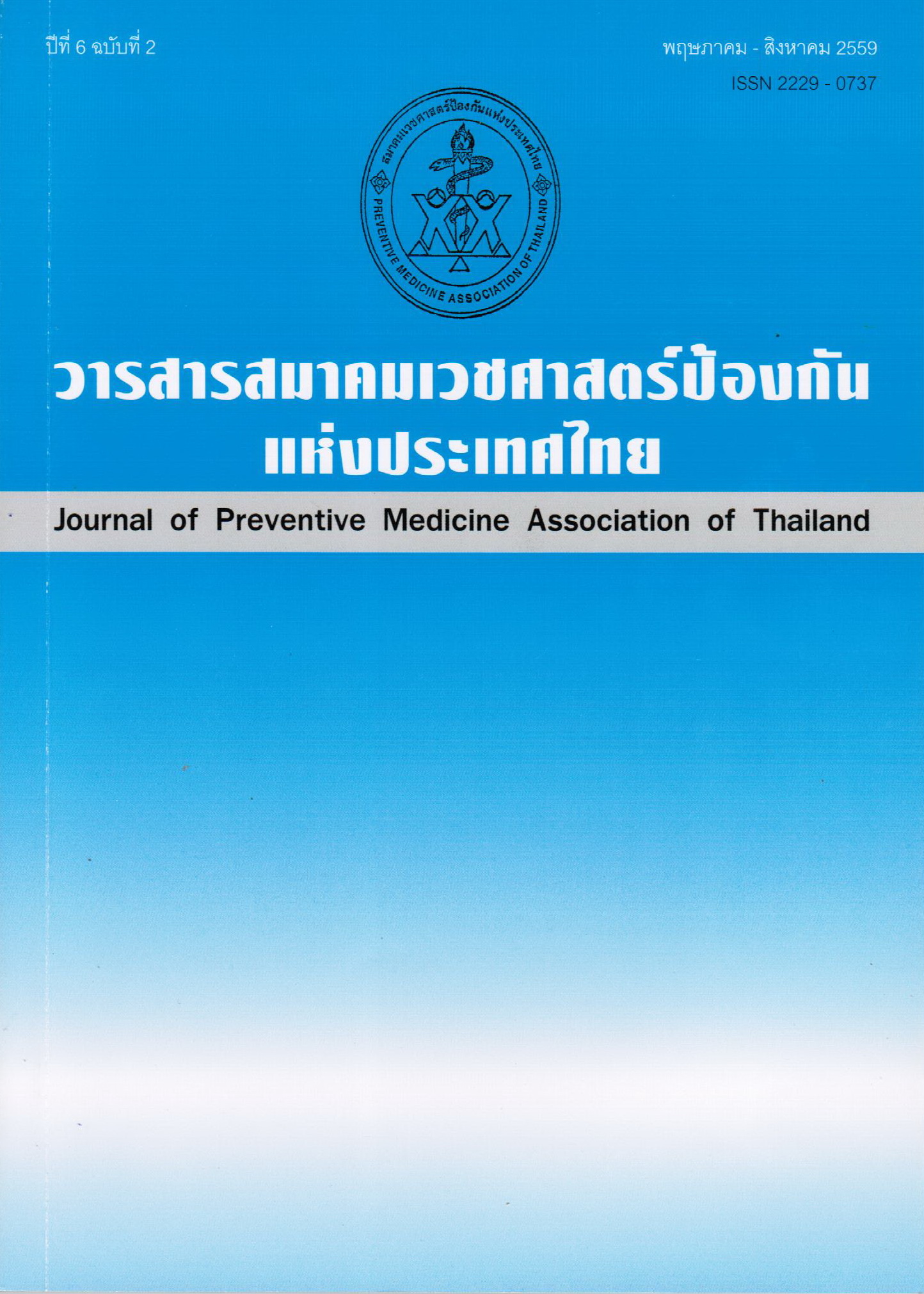Effects of Group Process Program on Knowledge and Behaviors of Disease Control and Blood Pressure of Essential Hypertensive Patients in Hypertension Clinic At Wiang Pa Pao Hospital, Chiangrai Province
Keywords:
Knowledge, Behavior of disease control, Blood pressure, Group process programAbstract
This experimental research aimed to study the effects of group process program on knowledge and behaviors of disease control and blood pressure of essential hypertensive patients. Sample consisted of 82 essential hypertensive patients who aged between 35 to 59 years old and treated at Hypertension Clinic, Wiang Pa Pao Hospital, Chiangrai Province.
They were primary selected by purposive sampling into experimental and control group with inclusion criteria, each group composed of 41 patients. Research instruments were the programs of group process, questionnaires and sphygmonometer. The results of this study revealed that the mean score of knowledge, behaviors of disease control and blood pressure of the experimental group was met that after the 8 th week of program of group process were better than before start this program. The results revealed statistically significant as (p<0.001). The mean score of knowledge about the disease, behaviors of disease control and blood pressure between the experimental group and the control group after the 8th weeks of program of group process and the 12th weeks of follow-up were difference. The statistically significant was shown as (p<0.001). The mean score of knowledge, behaviors of disease control and blood pressure of the experimental group in the trial period of intervention were different. Long-term follow-up after intervention program were better than before start the experimental program, which showed statistically significant as (p<0.001).
The results of this study indicated that the group process program helped essential hypertensive patients for more knowledge and better behaviors of disease control than past and lower blood pressure levels as well. This program can be extended to apply to the other group of patients with high blood pressure or other groups that were treated hypertension at primary or secondary care unit in Wiang Pa Pao district. We can apply this program to patients with other chronic non-communicable diseases.
References
2. Institute for Health Metrics and Evaluation. The Global Burden of Disease: Generating Evidence, Guiding Policy: Institute for Health Metrics and Evaluation; Seattle, WA: IHME, 2013.
3. ทักษพล ธรรมรังสี, วีรนุช ว่องวรรธนะกุล, วิชชุกร สุริยะวงศ์ไพศาล. รายงานสถานการณ์โรค NCDs วิกฤติสุขภาพ วิกฤตสังคม. พิมพ์ครั้งที่ 2. นนทบุรี: สำนักวิจัยนโยบายสร้างเสริมสุขภาพ สำนักงานพัฒนานโยบายสุขภาพระหว่างประเทศ (IHPP); 2557.
4. วิชัย เอกพลากร. การสำรวจสุขภาพประชาชนไทยโดยการตรวจร่างกาย ครั้งที่ 4 ในปี 2551-2552. นนทบุรี: บริษัท เดอะ กราฟิโก ซิสเต็มส์ จำกัด; 2553.
5. สำนักงานพัฒนานโยบายสุขภาพระหว่างประเทศ. รายงานภาระโรคและการบาดเจ็บของประชากรไทย พ.ศ. 2552. นนทบุรี: บริษัท เดอะ กราฟิโก ซิสเต็มส์ จำกัด; 2555.
6. โรงพยาบาลเวียงป่าเป้า จังหวัดเชียงราย. ข้อมูลคลินิกโรคความดันโลหิตสูง. เชียงราย: กลุ่มงานยุทธศาสตร์และงานประกัน. โรงพยาบาลเวียงป่าเป้า; 2557.
7. Michel Burnier. Medical Adherence and Persistence as the Cornerstone of Effective Antihepertensive Therapy. American Journal of Hypertension. 2006;19(11):1190-96.
8. The seventh report of the Joint National Committee on prevent, detection, evaluation and treatment of high blood pressure [database on the Internet]. NIH publication. 2003 [cited 2015 September 20th,]. Available from: URL: www.nhbi.nih.gov/guidelines/hypertension/jnc7full.pdf.
9. ภาควิชาสุขศึกษาและพฤติกรรมศาสตร์ คณะสาธารณสุขศาสตร์ มหาวิทยาลัยมหิดล. ทฤษฎีและโมเดล การประยุกต์ใช้ในงานสุขศึกษาและพฤติกรรมศาสตร์. กรุงเทพฯ: ยุทธรินทร์การพิมพ์; 2553.
10. ฉวีวรรณ บุญสุยา. สถิติวิจัยสำหรับงานสาธารณสุข. พิมพ์ครั้งที่ 2. กรุงเทพฯ: เสนาการพิมพ์; 2551.
11. มยุรี สร้อยศรีสวัสดิ์. เปรียบเทียบผลของการให้ความรู้และคำปรึกษาในผู้ป่วยความดันโลหิตสูงด้วยวิธีการกลุ่ม 2 รูปแบบ ในโรงพยาบาลพระพุทธบาท. [วิทยานิพนธ์]. นครปฐม: มหาวิทยาลัยศิลปากร; 2555.
12. กวี เมฆประดับ. ผลของการจัดโปรแกรมส่งเสริมสุขภาพเพื่อควบคุมและป้องกันภาวะแทรกซ้อนในผู้สูงอายุที่มีความดันโลหิตสูงอำเภอบางกระทุ่ม จังหวัดพิษณุโลก. [วิทยานิพนธ์]. เชียงใหม่: มหาวิทยาลัยเชียงใหม่; 2552.
13. จิราวดี สินไชย. ผลของการมีส่วนร่วมในกระบวนการพยาบาลต่อระดับการดูแลตนเองของผู้ป่วยเบาหวาน. ขอนแก่น: มหาวิทยาลัยขอนแก่น; 2557.
14. ปริชาติ กาญจนพังคะ. โปรแกรมการส่งเสริมการรับรู้สมรรถนะของตนเองต่อพฤติกรรมสุขภาพ และระดับความดันโลหิตสูง. [วิทยานิพนธ์]. พิษณุโลก: มหาวิทยาลัยนเรศวร; 2550.
15. สุภาวดี ตงสกุลรุ่งเรือง. เปรียบเทียบผลการให้คำปรึกษากับการให้ข้อสนเทศต่อพฤติกรรมสุขภาพของผู้ป่วยความดันโลหิตสูงชนิดไม่ทราบสาเหตุ โรงพยาบาลพระปกเกล้า จันทบุรี. [วิทยานิพนธ์]. ชลบุรี: มหาวิทยาลัยบูรพา; 2552.
16. สุธี วรรณา. การสร้างเสริมพฤติกรรมการดูแลสุขภาพตนเองของผู้ป่วยความดันโลหิตสูงชนิดไม่ทราบสาเหตุ กิ่งอำเภอวังสมบูรณ์ จังหวัดสระแก้ว. ขอนแก่น: มหาวิทยาลัยขอนแก่น; 2551.
Downloads
Published
How to Cite
Issue
Section
License
บทความที่ลงพิมพ์ในวารสารเวชศาสตร์ป้องกันแห่งประเทศไทย ถือเป็นผลงานวิชาการ งานวิจัย วิเคราะห์ วิจารณ์ เป็นความเห็นส่วนตัวของผู้นิพนธ์ กองบรรณาธิการไม่จำเป็นต้องเห็นด้วยเสมอไปและผู้นิพนธ์จะต้องรับผิดชอบต่อบทความของตนเอง






